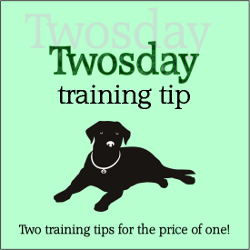 TIP #1: HOUSE TRAINING AN ADULT DOG Shouldn’t an adult dog know where to go? Ideally, yes. And dogs are naturally clean animals. Given a choice, they will go to the bathroom well away from where they sleep and eat. But it is not at all obvious to dogs that carpets and floors are inappropriate toilets - or that the bathroom rules in one place apply everywhere else. Teach your new family member to distinguish between indoors and outdoors by getting her to go in a designated area and then rewarding her with treats and praise. With a little patience and supervision, your dog will soon be fully versed in toilet etiquette. Note: If a house trained dog suddenly has accidents, call your veterinarian. Your dog could have a bladder infection or another medical problem. TIP #2: LEASH AGGRESSION (aka Why Otherwise Friendly Dogs May Behave Aggressively When On Leash) We know that aggression is caused by stress. Clearly, there is something about being on a leash that a lot of dogs find stressful enough that it prompts aggressive behavior. There are several reasons for this. Let's take a look at one of them. Picture in your mind two dogs meeting and greeting, off-leash. They engage in a social dance - advancing, retreating, moving around each other, sniffing various body parts, giving body language signals intended to keep the interaction civil. Sometimes the movements are slow; sometimes they are quick. If one dog is cautious or fearful of the other, he can retreat as he wishes, using social distance to keep himself safe. Now picture those same two dogs meeting on-leash. The dance is stilted, inhibited by the restraint of the leash. One dog tries to circle the other, and the leash tangles around his legs. The cautious dog would like to retreat to safety, but knows the leash restricts his movement, and elects to act out his second option to increase distance - a growl and a snap to signal to the other dog to move away - who cannot, because he is leashed. The fight is on. In the future, the cautious dog will offer a growl and snap before he's close enough for the other dog to make contact. The best defense is a good offense. Alarmed, owners move away from each other, and the fearful dog's aggression is reinforced by the increased distance. Behaviors that are reinforced repeat and increase, and the cautious dog's aggression escalates as he realizes that it's a successful behavior strategy for him - it keeps other scary dogs away. You now have a leash-aggressive dog. Absent the leash, he still chooses to move away from the other dog - his first behavior choice. - Whole Dog Journal Comments are closed.
|
AuthorJeff Dentler, CPDT-KA, IAABC-ADT, FFCP, CTDI Archives
July 2024
Categories |

 RSS Feed
RSS Feed